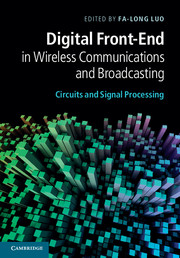Book contents
- Frontmatter
- Contents
- Contributors
- Preface
- Part I Introduction to digital front-end
- Part II DPD and CFR
- Part III DUC, DDC, ADC, DAC, and NCO
- 12 Digital down-conversion and up-conversion
- 13 A/D and D/A data conversion for wireless communications transceivers
- 14 Advanced quadrature sigma-delta modulator designs for A/D interface
- 15 Digital suppression of A/D interface nonlinearities
- Part IV Digital calibration, imbalance compensation, and error corrections
- Part V Circuits and system integration in digital front-end
- Index
- References
12 - Digital down-conversion and up-conversion
theory and implementation
from Part III - DUC, DDC, ADC, DAC, and NCO
Published online by Cambridge University Press: 07 October 2011
- Frontmatter
- Contents
- Contributors
- Preface
- Part I Introduction to digital front-end
- Part II DPD and CFR
- Part III DUC, DDC, ADC, DAC, and NCO
- 12 Digital down-conversion and up-conversion
- 13 A/D and D/A data conversion for wireless communications transceivers
- 14 Advanced quadrature sigma-delta modulator designs for A/D interface
- 15 Digital suppression of A/D interface nonlinearities
- Part IV Digital calibration, imbalance compensation, and error corrections
- Part V Circuits and system integration in digital front-end
- Index
- References
Summary
Digital conversion is a fundamental part of many digital radio systems, which include up-conversion of the discrete baseband signal stream into a high-resolution radio signal at the transmitter, and down-conversion of a high-resolution radio signal back into a baseband signal at the receiver. In this chapter, we cover the basics of digital conversion (analog to digital and digital to analog), the functionality of the digital up-converter (DUC) and digital down-converter (DDC) in relation to conversion between intermediate frequency (IF) and baseband with the emphasis on the implementation of the DDC and DUC for standard wireless communication systems.
This chapter is organized into six sections. The first section gives an introduction to the digital transceiver and related basic processing blocks. Section 12.2 will present the multi-rate, multi-stage and filter-banks design for a digital front-end. Section 12.2.1 will describe I/Q (In-phase/Quadrature) modulation/demodulation and NCO (numerical control oscillator) design for the DDC and DUC. Section 12.2.2 will present sample rate conversion design in the DDC. The multi-rate, multi-stage filtering and filter bank implementation is covered in this section. Section 12.2.3 will talk about sample rate conversion in the DUC.
Information
- Type
- Chapter
- Information
- Digital Front-End in Wireless Communications and BroadcastingCircuits and Signal Processing, pp. 333 - 379Publisher: Cambridge University PressPrint publication year: 2011
